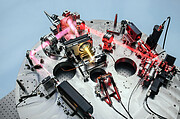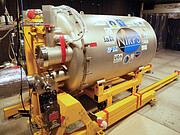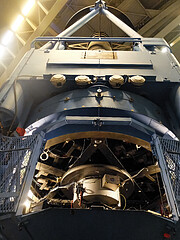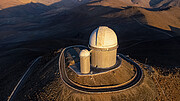Tiedote
Uusi planeettojen metsästäjä herää henkiin: NIRPS-instrumentti aloittaa havainnot
27. kesäkuuta 2022
La Sillan observatoriolla Chilessä ESO:n 3.6-m teleskoopin Near InfraRed Planet Searcher eli NIRPS-instrumentti on onnistuneesti tehnyt ensimmäiset havaintonsa. Sen tehtävänä on etsiä uusia eksoplaneettoja Linnunradan viileiden tähtien ympäriltä.
”NIRPSiä on rakennettu pitkään, ja olen innoissani siitä, miten tämä kaikki on saatu valmiiksi!”, Montréalin yliopiston eksoplaneettojen tutkimuslaitoksen johtaja ja NIRPS:n apulaispäätutkija René Doyon, sanoi. ”Tämä uskomaton infrapuna-instrumentti auttaa meitä löytämään omaa aurinkokuntaamme lähimmät asuttavat maailmat”.
Instrumentti keskittyy kivisten maailmojen etsimiseen. Nämä ovat erittäin tärkeitä planeettojen muodostumisen ja kehittymisen ymmärtämiseksi. Ne ovat myös todennäköisimpiä planeettoja, joissa elämä voi kehittyä. NIRPS etsii näitä kivisiä eksoplaneettoja pienten ja viileiden punaisten kääpiötähtien ympäriltä. Nämä ovat galaksimme yleisimpiä tähtiä, ja niiden massat ovat noin kahdesta kymmeneen kertaa pienempiä kuin Aurinkomme.
NIRPS etsii eksoplaneettoja radiaalinopeusmenetelmällä. Planeetan kiertäessä tähteä sen gravitaatiovoima saa tähden hieman ”heilumaan”, jolloin siitä tuleva valo puna- tai sinisiirtyy tähden liikkuessa Maasta poispäin tai sitä kohti. Mittaamalla tähden valon pieniä muutoksia tähtitieteilijät pystyvät NIRPSin avulla mitattaamaan planeetan massan, sekä muita ominaisuuksia.
NIRPS havaitsee näitä spektrin muutoksia lähi-infrapunavalon alueella. Pienet viileät tähdet ovat kirkkaimmillaan tällä aallonpituusalueella. Se liittyy HARPSin (High Accuracy Radial velocity Planet Searcher) seuraan uusien kivisten maailmojen metsästäjänä. HARPS on asennettu ESO:n 3.6-m teleskooppiin La Sillan observatoriolle Chileen ja se on ollut toiminnassa vuodesta 2003 lähtien. Se käyttää havainnoissa myös radiaalinopeusmenetelmää, mutta toimii näkyvän valon alueella. Molempien instrumenttien samanaikaisella käytöllä saadaan näitä kivisiä maailmoja tutkittua paremmin.
”NIRPS täydentää optimaalisella tavalla HARPS:ia kattamalla lähi-infrapuna-alueen aallonpituudet”, Céline Peroux, ESO:n NIRPS projektitutkija, kertoi. ”Tämä on ihanteellinen laite maankaltaisten eksoplaneettojen löytämiseksi punaisten tähtien ympäriltä”.
Toinen keskeinen ero näiden kahden instrumentin välillä on se, että NIRPS hyödyntää tehokasta adaptiivisen optiikan järjestelmää. Adaptiivinen optiikka on tekniikka, joka korjaa ilmakehän turbulenssin aiheuttamia vaikutuksia. Tämä ilmiö saa tähdet tukkimaan. Adaptiivisen optiikan ansiosta NIRPS itse on yli kaksi kertaa tehokkaampi eksoplaneettojen löytämisessä ja tutkimisessa.
”NIRPS liittyy hyvin pieneen korkean suorituskyvyn lähi-infrapuna alueella toimivien spektrografien joukkoon, ja sen odotetaan olevan havaintojen osalta tärkeässä roolissa, sekä toimivan yhdessä eri satelliittien, kuten James Webb -avaruusteleskoopin ja maanpäällisten observatorioden, kanssa”, François Bouchy, Geneven yliopistosta Sveitsistä ja yksi NIRPSin päätutkijoista, lisäsi.
Eräät maailman tehokkaimmat observatoriot, kuten ESO:n VLT-teleskooppi (Very Large Telescope) ja tuleva Erittäin suuri kaukoputki (Extremely Large Telescope) Chilessä (joille on kehitteillä samanlaisia instrumentteja), tulevat edelleen tutkimaan NIRPSillä ja HARPSilla tehtyjä havaintoja. Työskentelemällä yhdessä, sekä avaruus-, että maanpäälisten observatorioiden kanssa, NIRPS pystyy saamaan vihjeitä eksoplaneettojen koostumuksesta ja etsimään jopa elämän merkkejä niiden ilmakehistä.
NIRPS on rakennettu kansainvälisenä yhteistyönä, jota Kanadan Université de Montréalin yliopiston eksoplaneettojen tutkimuslaitos ja Sveitsissä sijaitseva Observatoire Astronomique de l'Université de Genève, ovat johtaneet.
Lisätietoja
NIRPS-konsortiossa mukana ovat: Université de Montréal, Kanada; Université de Genève, Observatoire Astronomique, Sveitsi; Instituto de Astrofísica e Ciências do Espaço, University of Porto & University of Lisbon, Portugal; Instituto de Astrofísica de Canarias, Espanja; Université de Grenoble, Ranska ja Universidade Federal do Rio Grande do Norte, Brazilia.
Yhteystiedot
François Bouchy
Observatoire Astronomique de l’Université de Genève
Puh.: +41 22 37 92 460
S-posti: francois.bouchy@unige.ch
René Doyon
Institute for Research on Exoplanets — Université de Montréal
Puh.: +1 514 343 6111 x3204
S-posti: rene.doyon@umontreal.ca
Celine Peroux
ESO Project Scientist for NIRPS
Puh.: +49 89 3200 6346
S-posti: cperoux@eso.org
Norbert Hubin
ESO Project Manager & Engineer for NIRPS
Puh.: +49 89 3200 6517
S-posti: nhubin@eso.org
Bárbara Ferreira
ESO Media Manager
Garching bei München, Saksa
Puh.: +49 89 3200 6670
S-posti: press@eso.org
Tiedotteesta
| Tunnistus: | ann22009 |
Our use of Cookies
We use cookies that are essential for accessing our websites and using our services. We also use cookies to analyse, measure and improve our websites’ performance, to enable content sharing via social media and to display media content hosted on third-party platforms.
ESO Cookies Policy
The European Organisation for Astronomical Research in the Southern Hemisphere (ESO) is the pre-eminent intergovernmental science and technology organisation in astronomy. It carries out an ambitious programme focused on the design, construction and operation of powerful ground-based observing facilities for astronomy.
This Cookies Policy is intended to provide clarity by outlining the cookies used on the ESO public websites, their functions, the options you have for controlling them, and the ways you can contact us for additional details.
What are cookies?
Cookies are small pieces of data stored on your device by websites you visit. They serve various purposes, such as remembering login credentials and preferences and enhance your browsing experience.
Categories of cookies we use
Essential cookies (always active): These cookies are strictly necessary for the proper functioning of our website. Without these cookies, the website cannot operate correctly, and certain services, such as logging in or accessing secure areas, may not be available; because they are essential for the website’s operation, they cannot be disabled.
Functional Cookies: These cookies enhance your browsing experience by enabling additional features and personalization, such as remembering your preferences and settings. While not strictly necessary for the website to function, they improve usability and convenience; these cookies are only placed if you provide your consent.
Analytics cookies: These cookies collect information about how visitors interact with our website, such as which pages are visited most often and how users navigate the site. This data helps us improve website performance, optimize content, and enhance the user experience; these cookies are only placed if you provide your consent. We use the following analytics cookies.
Matomo Cookies:
This website uses Matomo (formerly Piwik), an open source software which enables the statistical analysis of website visits. Matomo uses cookies (text files) which are saved on your computer and which allow us to analyze how you use our website. The website user information generated by the cookies will only be saved on the servers of our IT Department. We use this information to analyze www.eso.org visits and to prepare reports on website activities. These data will not be disclosed to third parties.
On behalf of ESO, Matomo will use this information for the purpose of evaluating your use of the website, compiling reports on website activity and providing other services relating to website activity and internet usage.
Matomo cookies settings:
Additional Third-party cookies on ESO websites: some of our pages display content from external providers, e.g. YouTube.
Such third-party services are outside of ESO control and may, at any time, change their terms of service, use of cookies, etc.
YouTube: Some videos on the ESO website are embedded from ESO’s official YouTube channel. We have enabled YouTube’s privacy-enhanced mode, meaning that no cookies are set unless the user actively clicks on the video to play it. Additionally, in this mode, YouTube does not store any personally identifiable cookie data for embedded video playbacks. For more details, please refer to YouTube’s embedding videos information page.
Cookies can also be classified based on the following elements.
Regarding the domain, there are:
- First-party cookies, set by the website you are currently visiting. They are stored by the same domain that you are browsing and are used to enhance your experience on that site;
- Third-party cookies, set by a domain other than the one you are currently visiting.
As for their duration, cookies can be:
- Browser-session cookies, which are deleted when the user closes the browser;
- Stored cookies, which stay on the user's device for a predetermined period of time.
How to manage cookies
Cookie settings: You can modify your cookie choices for the ESO webpages at any time by clicking on the link Cookie settings at the bottom of any page.
In your browser: If you wish to delete cookies or instruct your browser to delete or block cookies by default, please visit the help pages of your browser:
Please be aware that if you delete or decline cookies, certain functionalities of our website may be not be available and your browsing experience may be affected.
You can set most browsers to prevent any cookies being placed on your device, but you may then have to manually adjust some preferences every time you visit a site/page. And some services and functionalities may not work properly at all (e.g. profile logging-in, shop check out).
Updates to the ESO Cookies Policy
The ESO Cookies Policy may be subject to future updates, which will be made available on this page.
Additional information
For any queries related to cookies, please contact: pdprATesoDOTorg.
As ESO public webpages are managed by our Department of Communication, your questions will be dealt with the support of the said Department.





